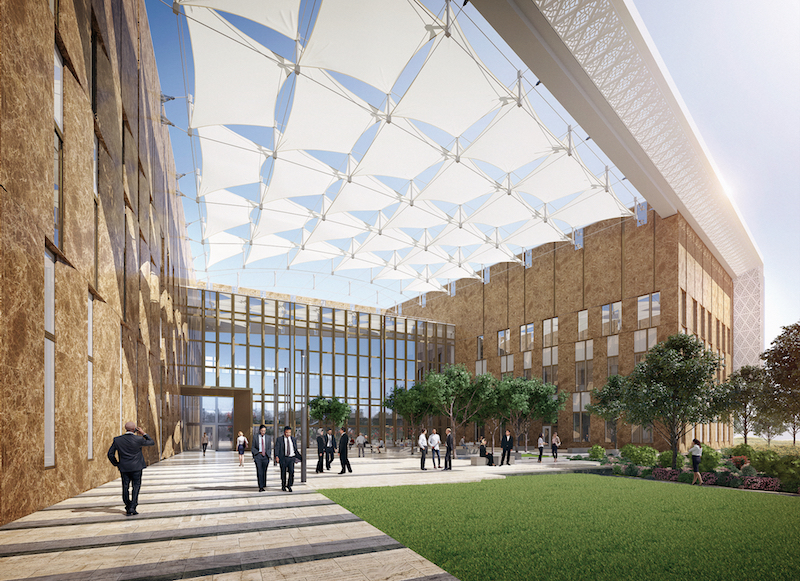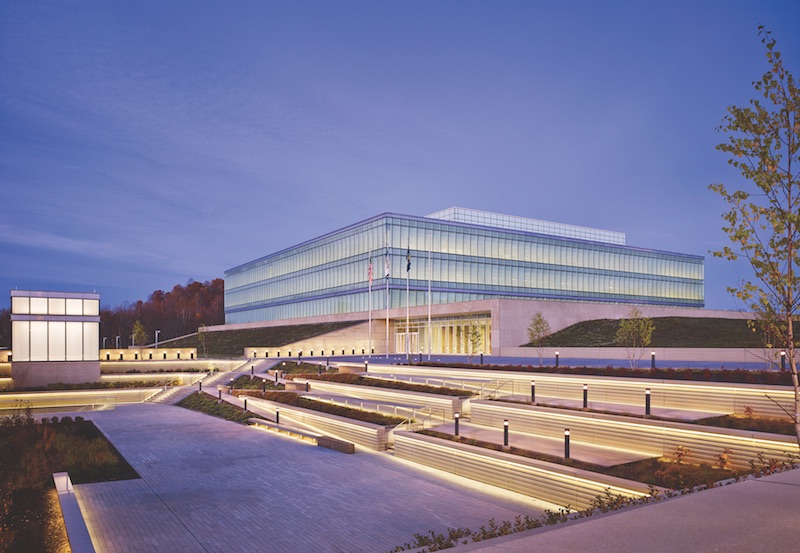The city of Chattanooga, Tenn., has been trying to get a new federal courthouse built for two decades. Its 84-year-old courthouse has been on the General Services Administration’s replacement list since 1999. But a new courthouse, which would cost around $157 million, once again fell just short of making the Federal Judiciary Courthouse Project funding priorities list for 2018.
So it goes for construction projects that are at the mercy of the political and budgetary vagaries of local, state, and federal governments.
Even the news that the Trump Administration’s 2018 budget calls for $200 billion in direct federal infrastructure spending over 10 years has AEC sources wondering whether that budget has any chance of passing, and how much of that money would end up financing nonresidential building and renovation.
Some firms are hopeful. “There is a lot of change occurring in all levels of government, which will create project opportunities,” says Karl Stumpf, AIA, LEED AP BD+C, Government Sector Leader with EYP.
Other firms, not so much. “Our federal healthcare clients know they are unlikely to see the level of capital investment to fulfill their current needs,” says Bill Kline, AIA, EDAC, LEED AP, who leads SmithGroupJJR’s Federal Programs–Healthcare group in Washington, D.C.
He notes that the Department of Veterans Affairs has identified 4,200 capital projects totaling more than $41 billion and 89 future projects totaling $10 billion, but is currently short $15 billion for capital improvements.
Seeking alternative funding sources
Public nonresidential construction spending was down in Q1/2017, according to Census Bureau estimates. But the value of construction put in place in March was still a seasonally adjusted $278 billion, evidence that governments are more selectively building, replacing, and improving
their inventories.
EYP’s Stumpf says all levels of government are still interested in investing in office projects that result in better space utilization and lower operating costs.
In May, the city of Gainesville, Fla., broke ground on a new 24,000-sf fire station, designed by Bentley Architects + Engineers. Gilbane Building Co. is serving as the CM at risk on this project, which comes on the heels of another fire station, administration, and headquarters facility that Gilbane recently completed for the city of Fort Myers, Fla.
But the inescapable fact is that local, county, and state governments are strapped for cash, or limited by balanced-budget mandates, to where “we’re not seeing public building projects, such as police and fire departments, municipal office buildings, courthouses, libraries, and community centers advancing quickly enough to meet community needs,” says Joseph Ruocco, AIA, Associate Director and Senior Project Manager with Skidmore, Owings & Merrill.
 The U.S. Consulate in Erbil, in Iraq’s Kurdistan region, will be the largest such facility in the world. Designer EYP is seeking to create a community whose features are familiar to Americans while also connecting to local culture. Rendering EYP.
The U.S. Consulate in Erbil, in Iraq’s Kurdistan region, will be the largest such facility in the world. Designer EYP is seeking to create a community whose features are familiar to Americans while also connecting to local culture. Rendering EYP.
Agencies at all levels are seeking to uncover new ways to get projects moving. The GSA now selectively employs a “real estate transaction exchange” with potential developers, where the agency offers land and development rights to a developer that provides a building designed to the agency’s specifications on a separate parcel. The developer gets the existing building that is being replaced and the land it’s sitting on, which it can use for future development.
Ruocco also notes that local, county, and state governments are more receptive to the design-build-finance-operate-maintain public-private partnership model, applied over a time frame that can extend 40 years.
At the federal level, SOM is finding that government agencies—such as the State Department’s Overseas Building Operations, the GSA, the Army Corps of Engineers, and the Naval Facilities Engineering Command—have successfully secured project funding over the past few years.
SOM has worked with OBO on new designs for missions in China. Last year, GSA secured congressional approval of nearly $947 million for its Federal Courthouse Program. Funding has been approved for new courthouses in Harrisburg, Pa., Huntsville, Ala., and Fort Lauderdale, Fla., to start building next year.
In St. Louis, the National Geospatial-Intelligence Agency West, a $1.75 billion, 800,000-sf facility, is slated to start construction next year, with completion scheduled for late 2022. Ruocco says this is one of the largest-scale projects to be issued since the Department of Defense’s 2005 Base Realignment and Closure Commission program in 2005.
Also See: BD+C Giants 300 government rankings
Top 95 government architecture firms
Top 55 government engineering firms
Top 85 government construction fimrs
SmithGroupJJR has established a relationship with the Department of Defense’s National Intrepid Center of Excellence (NICoE), a research, diagnostic, and treatment center for soldiers with traumatic brain injuries and post-traumatic stress, whose main facility is the Walter Reed National Military Medical Center, Bethesda, Md.
Arnold Fisher, Chairman of the Intrepid Fallen Heroes Fund, which led the initial fundraising drive for NICoE, has commissioned SmithGroupJJR to design template satellite centers for nine military bases, whose construction will be financed by the Intrepid Fallen Heroes Fund and gifted to the government upon completion.
The firm will complete the sixth of nine satellites this fall, at the Joint Base Lewis McCord, Tacoma, Wash., and has the seventh under construction at Camp Pendleton, in San Diego.
A fraught supply-chain ruling
Governments’ real estate holdings are vast, and its need to renovate and replenish its building stock will always present opportunities to AEC firms. Ruocco notes that many 1970s-era urban renewal projects are approaching their 50-year shelf life. “It’s time for their modernization or replacement,” he says.
But projects are more complicated today than they were a few generations ago. One potential game changer, says Kline, could be the fallout from a recent Supreme Court decision, Kingdomware Technologies, Inc. v. United States, which regards the implementation of set-aside requirements for veteran-owned small businesses under Federal Supply Schedule contracts.
The Court ruled that if two qualified disabled veteran-owned firms are available, the VA must contract with them over any other firm. That ruling, says Kline, will, at the very least “change the strategy architects and engineers use when competing for VA work.”
SEE ALL 2017 GIANTS 300 RANKINGS
Related Stories
| Aug 11, 2010
Clark Group, Hensel Phelps among nation's largest federal government contractors, according to BD+C's Giants 300 report
A ranking of the Top 40 Federal Government Contractors based on Building Design+Construction's 2009 Giants 300 survey. For more Giants 300 rankings, visit http://www.BDCnetwork.com/Giants
| Aug 11, 2010
National Intrepid Center of Excellence tops out at Walter Reed
SmithGroup and The Intrepid Fallen Heroes Fund (IFHF), a non-profit organization supporting the men and women of the United States Armed Forces and their families, celebrated the overall structural completion of the National Intrepid Center of Excellence (NICoE), an advanced facility dedicated to research, diagnosis and treatment of military personnel and veterans suffering from traumatic brain injury.
| Aug 11, 2010
Jacobs, HDR top BD+C's ranking of the nation's 100 largest institutional building design firms
A ranking of the Top 100 Institutional Design Firms based on Building Design+Construction's 2009 Giants 300 survey. For more Giants 300 rankings, visit http://www.BDCnetwork.com/Giants
| Aug 11, 2010
GSA celebrates 60th anniversary
The U.S. General Services Administration today is commemorating its 60th anniversary as it engages in one of its its most challenging assignments ever—helping to achieve the goals of the American Recovery and Reinvestment Act.
| Aug 11, 2010
H2M designs versatile fire station for Air National Guard
A new fire station at Stewart Air National Guard Base near Newburgh, N.Y., provides fire and crash rescue services for the New York Air National Guard's 105th Airlift Wing. The station offers much-needed bunk, living, and training areas for the unit. A/E firm H2M designed a cantilevered Alarm Center with direct views of taxiways, runways, and aircraft parking areas.
| Aug 11, 2010
Douglas County sheriff's station blends in with Colorado town
Ground has been broken on the Douglas County Sheriff Substation in Highlands Ranch, Colo. The 36,000-sf law enforcement facility features large translucent wall panels that blend the building in with the architectural features of the neighboring Highlands Ranch Town Center. The substation, designed by Pahl Architecture and built by Mark Young Construction, is on track for LEED Silver certificat...
| Aug 11, 2010
New building focuses on public safety
The $40 million public safety building for the city of El Cajon, Calif., is under construction and slated for completion in June 2011. The five-story, 119,400-sf building will house the city’s administrative offices, a joint police and fire emergency operations center, central data center, indoor firing range, crime lab, and short-term custody facility.
| Aug 11, 2010
Citizenship building in Texas targets LEED Silver
The Department of Homeland Security's new U.S. Citizenship and Immigration Services facility in Irving, Texas, was designed by 4240 Architecture and developed by JDL Castle Corporation. The focal point of the two-story, 56,000-sf building is the double-height, glass-walled Ceremony Room where new citizens take the oath.
| Aug 11, 2010
29 Great Solutions
1. Riverwalk Transforms Chicago's Second Waterfront Chicago has long enjoyed a beautiful waterfront along Lake Michigan, but the Windy City's second waterfront along the Chicago River was often ignored and mostly neglected. Thanks to a $22 million rehab by local architect Carol Ross Barney and her associate John Fried, a 1.







